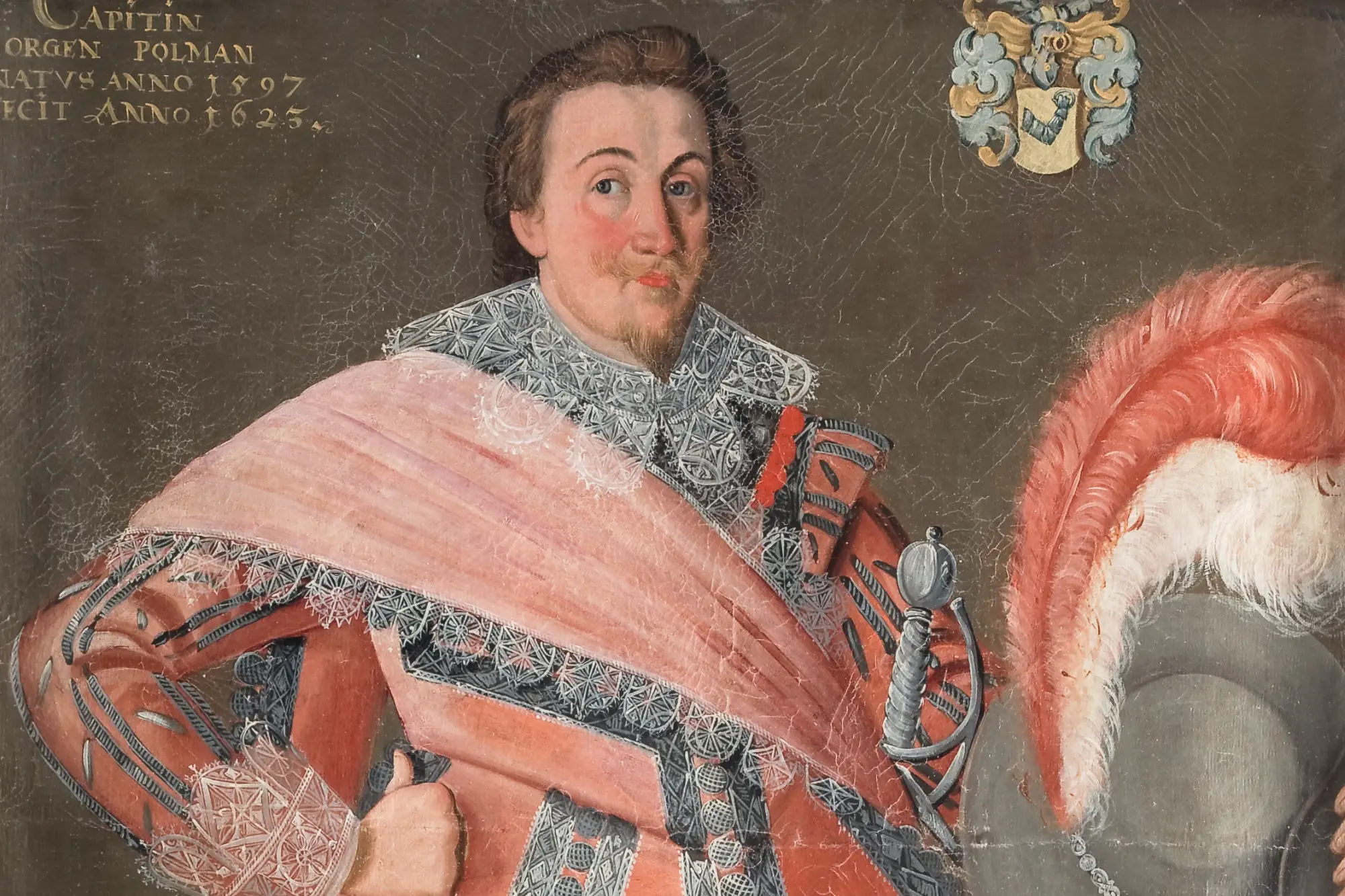The Multifaceted Leader
Adolf Fredrik Påhlman was the youngest son of Lieutenant Colonel Carl Gustaf Påhlman and Christina Elisabet Renner, born at the manor Ugglansryd in Sweden on 17 November 1743.[[1]] At the age of 13, he volunteered in the Kronoberg regiment, becoming a sergeant in 1760, followed by the titles of livdrabrant or bodyguard (1764) and a lieutenant in the army (1768).

In 1772, Adolf received the Royal Order of the Sword (Riddare av Svärdsordern), and between 1772 and 1776, he served as a lieutenant in French service with the Royal Suédois regiment. In 1776, he became a captain, and then was promoted to major in 1782.
An article from 1784 provides an insight into Adolf’s life outside his military career – he suggested the need for a new organ for the Söraby Church in Småland, recommending renowned organ builder Pehr Schiörlin of Linköping. The bleachers and facade were built by Swedish architect Olof Tempelman:[[2]]
“The richly decorated facade includes features characteristic of the Gustavian era such as fire clocks, flower baskets and garlands. The crowning star within a laurel wreath and the two portrait medallions, however, are surprising elements in this context. The ornamentation of the organ facade is therefore completely profane. Even the decor of the altar ornament and the pulpit show the extent to which the Christian symbols and images have fallen out of use within pure classicism.”
Between 1788 to 1790, Adolf served in the Finnish War, also known as the third Russo-Swedish war of the century,[[3]] through which Sweden sought to regain lost territory in Finland. In 1788, he was involved in the fighting at Fredrikshamn, from which Sweden eventually retreated; in 1789, he was lieutenant colonel in the Kronoberg regiment and commanded them at Anjala, Uttismalm and Värälä, including a crucial two-and-a-half month encounter at Liikkala. In 1790, he was a colonel in the army at Värälä and then commanded the battle of Valkeala – led by King Gustav III himself – during which he sustained a foot injury from a scrap bullet which was fortunately not dangerous.[[4]]

“Kronoberg’s regiment participated in the same with great distinction. During the attack on the height where the enemy had taken up a firm position, the Swedish battalions were forced, due to the nature of the terrain, to approach in a narrow column. First Kronoberg’s battalion under Lt. Påhlman had the lead and had to endure the enemy’s worst fire, while the others advanced to the right and left of the same. Lt. Col. Påhlman was wounded, but Gen. Major Pauli put himself at the head of the battalion and led it to attack.”[[5]]
Despite being wounded, Adolf continued his military exploits, commanding several regiments including Kronoberg, Hälsinge, and Bohuslän, as well as Elimä hunter battalion, Nyland’s dragoon regiment and Swedish Cossacks in the attack at Nappa village near Keltis. He was also briefly in charge of 3000 men at Jaala and surrounding posts. The war eventually ended with a Swedish victory. For his service, Adolf was presented with a sword by King Gustav III.[[6]]
“Thanksgiving services were celebrated throughout the kingdom. On May 2, 1790, the Te Deum was sung in Valkeala, after which Gustaf III granted the pardon as a reward. Major General af Pollet was appointed Commander of the Order of the Sword. Major General Pauli, Lieutenant Colonel Påhlman and Captain Berell were presented with swords.”
Adolf went on to become lieutenant colonel at the Södermanland regiment in 1792, and colonel for the Bohuslän regiment from 1793. During this time, he wrote a letter of support for a captain in his regiment:[[7]]
“[I] request your favour to bestow upon Letter Carrier Captain Lemke, who has served as Lieutenant in the Royal Bohuslän Regiment over which I preside, but who, as a poor lad with a meagre salary, has requested and received his resignation in hopes of finding better prospects in foreign service. […] He served in the last war in Finland, is proficient in several languages, and has strong military knowledge, and he has always conducted himself in a good manner and I wish that, especially considering his current mediocre state, that he immediately may receive an Officer’s promotion, which to him is the ultimate goal.”

Adolf resigned from his military career on 7 March 1796 – it was time for him to have new experiences. In 1797, at the age of 54, he married 20-year-old Margareta Elisabet Ankarcrona[[8]] in Runsa. They had nine children between 1798 and 1815, named Gustaf Vilhelm (1798-1836), Charlotta Elisabet (1799-1799), Carl Fredrik (1800-1885), Salomon (1801-1802), Maria Sofia (1802-1839), Margareta Lovisa (1806-1826), twins Adolf Fredrik (1811-1885) and Charlotta Elisabet (1811-1868), and Otto Conrad (1815-1815). Six survived to adulthood.
Adolf’s interest in religion and politics is indicated through his involvement in the 1823 Riksdag, wherein he “sought to influence Bishop Carl Fredrik af Wingård to take the initiative” in a matter regarding the printing of blasphemous content in the press.[[9]]
Adolf Fredrik Påhlman died on 23 March 1825 in Lidköping.
[[1]]: “Påhlman nr 501”, Adelsvapen-Wiki, https://www.adelsvapen.com/genealogi/P%C3%A5hlman_nr_501#TAB_27, accessed: 12 June 2023
[[2]]: Erik Cintio and Sigurd Curman, Kyrkobyggnader 1760-1860: Konsthistoriskt Inventarium / 2 Småland och Öland [Church buildings 1760-1860: Art historical inventory / 2 Småland and Öland], (Stockholm: Almqvist & Wiksell International, 1993), 61
[[3]]: “Russo-Swedish War of 1788-1790 Began,” Presidential Library, https://www.prlib.ru/en/history/619352
[[4]]: E. Reuterswärd, Ett massmedium för folket: Studier i de allmänna kungörelsernas funktion i 1700-talets samhälle [A mass medium for the people: Studies in the function of public announcements in 18th century society], (Lund: Historiska Media/Nordic Academic Press, 2001), 261
[[5]]: Julius Mankell, Anteckningar rörande svenska regementernas historia, (Sweden: N.M. Lindh, 1866), via https://detgodasamhallet.com/2021/04/29/hi#at-pa-natet-svensk-seger-i-slaget-vidvalkeala/
[[6]]: Henrika Tandefelt, “Gustaf III inför sina undersåtar – konsten att härska och politikens kulturhistoria”, (University of Helsinki, 2007), 344
[[7]]: A. Påhlman to Curt Bogislaus Ludwig Kristoffer von Stedingk, 7 July 1795
[[8]]: Born on 13 March 1777 at Boserup in Risekatslösa parish, daughter of Major Conrad Vilhelm Ankarcrona and Countess Margareta Elisabet Reenstierna.
[[9]]: Harry Lenhammar, Religion och tryckfrihet i Sverige 1809-1840 [Religion and freedom of the press in Sweden 1809-1840], Acta Universitatis Upsaliensis, vol. 26 (Upsaliensia: Almqvist & Wiksell, 1974), 149




